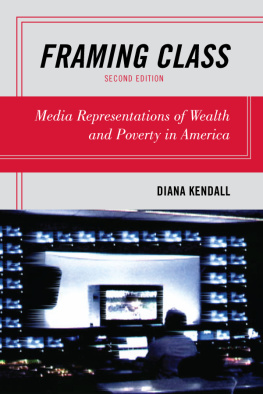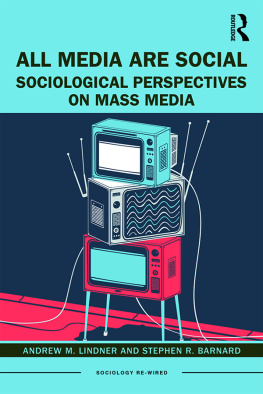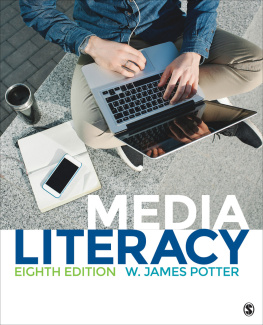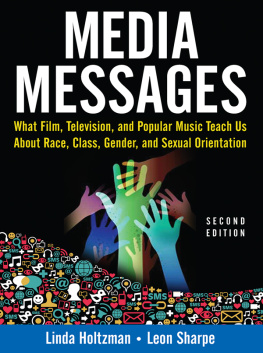Framing Class
Framing Class
Media Representations of
Wealth and Poverty in America
Second Edition
Diana Kendall
Rowman & Littlefield Publishers, Inc.
Lanham Boulder New York Toronto Plymouth, UK
Published by Rowman & Littlefield Publishers, Inc.
A wholly owned subsidiary of The Rowman & Littlefield Publishing Group, Inc.
4501 Forbes Boulevard, Suite 200, Lanham, Maryland 20706
http://www.rowmanlittlefield.com
Estover Road, Plymouth PL6 7PY, United Kingdom
Copyright 2011 by Rowman & Littlefield Publishers, Inc.
All rights reserved . No part of this book may be reproduced in any form or by any electronic or mechanical means, including information storage and retrieval systems, without written permission from the publisher, except by a reviewer who may quote passages in a review.
British Library Cataloguing in Publication Information Available
Library of Congress Cataloging-in-Publication Data
Kendall, Diana Elizabeth.
Framing class : media representations of wealth and poverty in America / Diana Kendall. 2nd ed.
p. cm.
Includes bibliographical references and index.
ISBN 978-1-4422-0223-8 (cloth : alk. paper) ISBN 978-1-4422-0224-5 (pbk. : alk. paper) ISBN 978-1-4422-0225-2 (electronic)
1. Mass mediaSocial aspectsUnited States. 2. Social classesUnited States. 3. United StatesSocial conditions. I. Title.
HN90.M3K46 2011
302.230862dc22
2010047438
 The paper used in this publication meets the minimum requirements of American National Standard for Information SciencesPermanence of Paper for Printed Library Materials, ANSI/NISO Z39.48-1992.
The paper used in this publication meets the minimum requirements of American National Standard for Information SciencesPermanence of Paper for Printed Library Materials, ANSI/NISO Z39.48-1992.
Printed in the United States of America
Acknowledgments
I am solely responsible for the contents of this book; however, in the eight years in which I have researched and written the first two editions of Framing Class , I have incurred many debts to people who have provided me with encouragement and assistance. First of all, I wish to thank Jessica Farrar, a former graduate student at Baylor University, who has worked untiringly, helping me to update statistics and find newer and better examples of the media framing approaches that I describe in this book. Second, I would like to honor the memory of the late Alan D. McClare of Rowman & Littlefield, with whom I had a wonderful friendship and a long working relationship as editor-author before his untimely death in 2009. Alan helped me to bring several books to fruition with Rowman & Littlefield, and he was a constant encouragement on my other research and writing projects as well. Third, I am extremely grateful to Sarah Stanton, my current acquisitions editor, for the energy and enthusiasm that she has brought to the task of publishing the second edition of Framing Class . Jin Yu, editorial assistant, has been most helpful in working with the technical aspects of this manuscript, and the copyeditor, Jennifer Kelland, and production editor, Janice Braunstein, have helped to make this a far better book than it otherwise might have been.
Chapter 1
Class Action in the Media
San Francisco, California:
They liveand dieon a traffic island in the middle of a busy downtown street, surviving by panhandling drivers or turning tricks. Everyone in their colony is hooked on drugs or alcohol. They are the harsh face of the homeless in San Francisco.
The traffic island where these homeless people live is a 40-by-75 foot triangle chunk of concrete just west of San Franciscos downtown.... The little concrete divider wouldnt get a second glance, or have a nameif not for the colony that lives there in a jumble of shopping carts loaded with everything they own. Its called Homeless Island by the shopkeepers who work near it and the street sweepers who clean it; to the homeless, it is just the Island. The inhabitants live hand-to-mouth, sleep on the cement and abuse booze and drugs, mostly heroin. There are at least 3,000 others like them in San Francisco, social workers say. They are known as the hard core, the people most visible on the streets, the most difficult to help....
Every effort to help the Islandersfrom family, probation officers, drug counselors, homeless aid workershas failed. They have been in and out of hospitals or methadone programs and jails... so many times even they have lost count. We want to get off the street, but I got to tell you true, [Tommy, a homeless man, said], Unless they take people like us and put us somewhere we cant keep fing up, were going to keep fing up.
How does this excerpt from a newspaper article make you feel about homeless people? Based on this news account, most newspaper readers would have a hard time feeling sympathy for the inhabitants of Homeless Island. To the contrary, they typically react to the situation depicted above, as reported in a San Francisco Chronicle series Shame of the City, with disgust, thinking, Yeah, thats the sort of homeless people who are the problembums who sleep on the cement, abuse drugs and alcohol, and panhandle for the money it takes to support their habit.
Compare that media-generated account of San Franciscos homeless population with this one, also from a newspaper article:
Hes OK, Michelle, 48, said of San Francisco Police Officer Matt Maciel one afternoon after he gently told them to move their carts and then asked if they had enough to eat. Hes just doing his job.
Michelle remembers when she might have been the one calling the cops on people leaving needles outside her house. She was born... in Colorado... and was sexually abused as a child. Her dad was shotgunned to death young, and her mother was a drug addict gone to cancer. But before Michelle crash-landed at the Island five years ago, she worked as a home health aide and wore smart, pressed dresses.
She dreams of getting back to that life. That cop might be the guy who helps me, or maybe the jail peopleit could be anybody, she said, giving Maciel a smile as he drove off. I just need another chance.
Based on this article, readers might feel some degree of sympathy for the homelessespecially for homeless people like Michelle. Surprisingly, both of these depictions of the homeless were written by the same reporter and ran in the same newspaper. Together, they show how media framing of a particular news story or television program often influences how we feel about the people described, especially when the subject relates to wealth, poverty, or the future of the middle class. The manner in which the media frame class has a major impact on how people feel about class and inequality. For example, most people in the United States are not really middle class (since that would be statistically impossible); yet, most of us think that we belong in this categoryat least partly because the media define the middle class in such a way that most of us can easily self-identify with it.
Why Framing Class?
In writing Framing Class I aim to demonstrate how newspaper articles and television entertainment programs contribute to the social construction of reality about class in the United States, including the manner in which myths and negative stereotypes about the working class and the poor create a reality that seemingly justifies the superior positions of the upper-middle and upper classes and establishes them as entitled to their privileged position in the stratification system. Although I started this chapter with an example of how the media frame stories about homeless peoplethose at the bottom of the class hierarchythe interest in class-based media research that led me to write this book initially related to the upper and upper-middle classes. When conducting research for The Power of Good Deeds: Privileged Women and the Social Reproduction of the Upper Class , I became aware of how little has been written about media representations of class, particularly the U.S. upper or privileged class. Though some scholars have examined media content in relation to race and gender, class remains largely overlooked or deeply enmeshed in the larger race/class/gender sociological paradigm in these studies. Framing Class specifically focuses on class to fill in the gap pertaining to media representations of class; however, I am not suggesting that class is more important than race or gender in studying inequality. Rather, this volume reflects my belief that we must consider class as the media frame it, especially in television entertainment programs and national newspapers, in its own right as a form of reality construction and maintenance.









 The paper used in this publication meets the minimum requirements of American National Standard for Information SciencesPermanence of Paper for Printed Library Materials, ANSI/NISO Z39.48-1992.
The paper used in this publication meets the minimum requirements of American National Standard for Information SciencesPermanence of Paper for Printed Library Materials, ANSI/NISO Z39.48-1992.